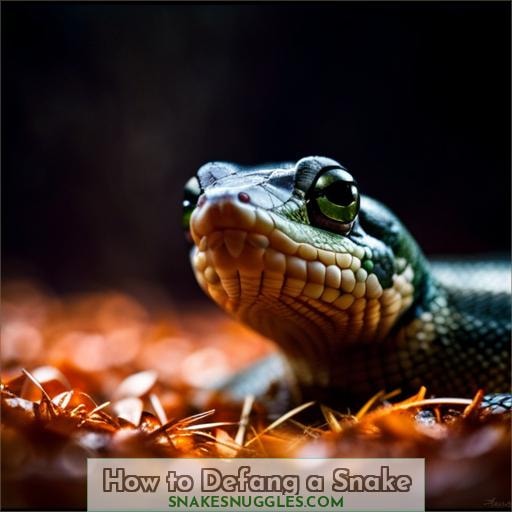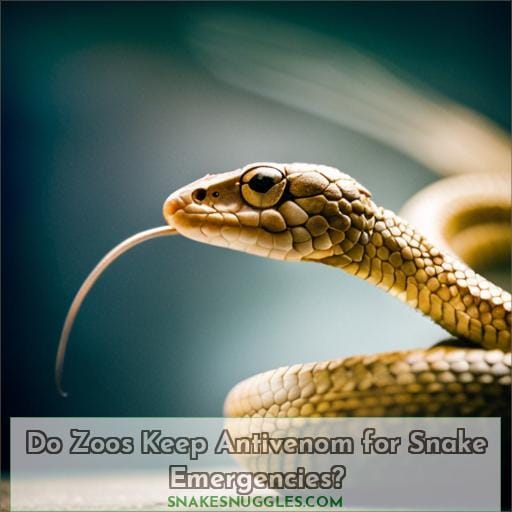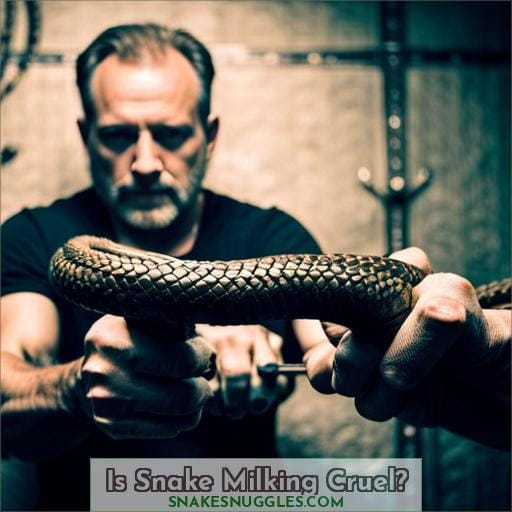This site is supported by our readers. We may earn a commission, at no cost to you, if you purchase through links.

Defanging is the act of removing a snake’s fangs in order to render them non-venomous and prevent injury when handling. This procedure can be done surgically or by clipping their fangs; however, there are risks associated with both methods that must be considered before undertaking this task.
In addition to potentially causing great pain for your pet reptile, it also disrupts normal feeding behavior as well as alters natural features like coloration and scale patterning which could lead to medical issues down the line if not addressed properly.
To ensure that you carry out this process safely and responsibly while keeping your beloved pet healthy and happy, we will explore all aspects of defanging snakes so you have all the knowledge necessary before making such an important decision.
Table Of Contents
- Key Takeaways
- Can You Defang a Snake?
- Considerations for Defanging Snakes
- How to Defang a Snake
- Can Snakes Eat Without Fangs?
- Can Snakes Survive Their Own Bite?
- Do Zoos Keep Antivenom for Snake Emergencies?
- Do Snakes Lose Their Fangs When They Bite?
- Do Snakes Sleep After Eating?
- What Are Fangs and Their Purpose?
- Is Snake Milking Cruel?
- Conclusion
Key Takeaways
- Defanging snakes involves surgical or clipping methods, which pose risks such as pain, infection, altered behavior, and disrupted feeding.
- Ethical dilemmas arise due to potential pain and behavioral changes caused by defanging, as well as the creation of venomoid snakes.
- Expertise is crucial for safe defanging and responsible snake ownership, with veterinary opinions varying on the practice and suggesting alternatives.
- Removing snake fangs can lead to health issues, including mouth rot and reduced survival rates, highlighting the importance of considering alternatives to defanging.
Can You Defang a Snake?
Are you considering defanging a snake? It is important to know the risks and considerations before doing so, such as how fangs are removed, whether it can kill the snake or not, why people opt for this process in the first place, and if it’s safe to do at home.
Understanding these topics can help inform your decision on whether you should go through with defanging a snake.
How Are Snake Fangs Removed?
You might consider fang removal for educational purposes in a controlled setting, but it is important to note that the process involves anesthesia and tools, as well as risks such as pain and infection.
The techniques used vary depending on the species of snake, with ethical dilemmas surrounding defanging due to illegal wildlife trade. Anesthesia considerations are essential when removing venomous snakes’ fangs; regrowth timelines must be taken into account for safety reasons.
Fang removal should only be done by experienced professionals who understand its consequences and implications.
Does Defanging a Snake Kill It?
Defanging a snake is possible but has serious consequences. It results in the loss of venom glands and can lead to pain, infection, mouth rot, and reduced survival rates. Ethical considerations must be made as well as exploring alternatives that are less damaging to the animal’s well-being.
Regrowth of fangs also poses an envenomation risk, while behavioral changes may occur due to defanging procedures.
Why Do People Defang Snakes?
People may choose to remove a snake’s fangs, like pulling petals from a flower, in order to keep them safe and protect others. Defanging techniques involve removing the fangs or venom glands of venomous snakes, resulting in non-venomous creatures called venomoids.
Ethical considerations are important due to potential pain and feeding difficulties for the snake. Fang regrowth can occur with repeated defanging; educational purposes might be considered, but risks such as mouth rot remain.
Should You Defang Snakes?
Considering the risks and considerations associated with defanging venomous snakes, one must ask themselves if it is a responsible move. Ethical implications are at play when considering the behavioral changes that may occur due to fang regrowth or lack thereof.
Veterinary opinions may differ in this matter, as some suggest educational alternatives such as venomoid breeding for scientific research purposes rather than invasive species removal methods like defanging.
Ultimately, one should weigh all pros and cons carefully before deciding whether or not to follow through with snake breeder recommendations of defanging for educational purposes.
Can You Remove Snake Fangs at Home?
Removing snake fangs at home is a perilous venture and should only be attempted with extreme caution – like walking on eggshells! DIY fang removal can cause pain, infection risks, and mouth rot. Home defanging has no place in the venom delivery system or safe ownership of native venomous snakes.
Untrained extraction carries many dangers; professional care is the best way to ensure safety for both the handler and the snake.
Considerations for Defanging Snakes
Defanging a snake has multiple considerations, including the consequences of fang removal, safety and legal implications, natural characteristics of fangs and venom delivery systems in snakes, medical aspects required to defang a snake safely, as well as the expertise needed for responsible ownership.
Understanding these factors is essential when considering whether or not to defang a snake.
Consequences of Defanging
Being aware of the consequences of defanging is important. Fang removal risks include molar damage, feeding problems, and loss of venom effects. Ethical considerations also arise when contemplating this process as the health impact and fang regrowth are unknowns.
Snake bites are still possible despite fang replacement; caution is required when handling venomous snakes.
Safety and Legality of Defanging
When it comes to defanging venomous snakes, safety and legality are crucial. Legal implications vary; pet ownership regulations differ in each area. Sedation safety must be ensured; veterinary guidelines for anesthesia should be followed.
Controlled educational use might be considered, and the ethics of the process should be discussed as well. Snake owners need to take responsibility to ensure safe handling practices at all times.
Natural Fang Characteristics
You may not be aware, but snakes’ fangs have multiple purposes. Fang growth and replacement occur naturally when shed, while the evolutionary significance lies in their development for defense and feeding.
Unhinging jaws allow venom delivery; however, snake milking is harmful. Thus, natural characteristics must be understood prior to defanging a snake safely and responsibly.
Medical Aspects of Defanging
Proper medical attention is crucial when considering defanging a snake. Using pliers without anesthesia can lead to severe mouth rot. It is important to consider anesthesia options, the timeline for fang regrowth, prevention of self-biting, and the rapid effects of venom.
Exploring veterinary alternatives for rattlesnake bites is also necessary to ensure the safety and health of the animal.
Expertise and Responsibility in Snake Ownership
Owning a venomous snake demands expertise and responsibility. Understanding reptile behavior, digestion, and venom immunity is necessary to ensure safety measures are taken for ethical ownership. Expert care is crucial for handling snakes; improper techniques can cause injury or death for both the handler and the reptile.
Appropriate enclosures should have limited contact with humans, and cleanliness protocols should be in place for successful maintenance of the species’ health over time. Taking all these considerations into account will allow owners to safely enjoy the unique bond between them and their scaled companion.
How to Defang a Snake
Defanging a snake involves the removal of the animal’s venom glands or fangs, turning it into a non-venomous version known as a venomoid. The process requires tools such as anesthesia and clippers, which are typically used cautiously to minimize pain for the animal.
However, there are risks associated with defanging due to potential complications like feeding difficulties or infection from mouth rot.
The Defanging Process
Defanging a venomous snake requires anesthesia and specialized tools, but is it worth the risks? There are ethical considerations as well; a defanged snake may experience pain during fang regrowth and could be subject to infection.
The venomoid controversy surrounds home removal of fangs with clippers or pliers, while antivenom storage for emergencies remains essential. Rat snakes often self-bite after eating due to sleep paralysis – an extra precaution when considering defanging any species.
Tools and Techniques for Defanging
When it comes to defanging a snake, you need the right tools and techniques for the job. Anesthesia considerations, post-defanging care, ethical dilemmas, and veterinary involvement are all important factors to consider.
Anesthesia is paramount in any procedure. Proper safety measures must be taken when milking venom or removing fangs.
Ethical concerns arise from permanently altering a creature’s natural behavior without consent.
Post-operative care includes wound management with antibiotics as well as regular monitoring for infection levels and feeding difficulties.
It is best to involve experienced reptile vets in all aspects of defanging precautions, such as assessing an animal’s suitability prior to undergoing treatment.
Risks and Complications of Defanging
Although it may seem appealing, tampering with a venomous snake’s fangs can lead to numerous risks and complications. Defanging is associated with pain, infection risk, and feeding difficulties. There are also ethical concerns regarding the suitability of owning such snakes.
Anesthesia considerations should also be taken into account during the process due to the potential for mouth rot post-removal and partial regrowth, which could result in envenomation.
Appropriate safety measures must be used when handling these animals. Experts advise against attempting defanging at home or without professional assistance. Proper care and responsible ownership are key factors in keeping venomous snakes safe from harm while avoiding potential effects on their natural behaviors caused by defanging them.
Can Snakes Eat Without Fangs?
Without their fangs, snakes can still survive and eat. Yes, venomous snakes rely on their sharp fangs for defense and hunting prey, but they can adapt to a life without them. Some reptiles have the ability to regenerate lost body parts like tails or limbs, but this is not true for all snake species.
Predators without external features like horns or claws use nutritional adaptations to consume food effectively, rather than relying solely on physical characteristics like venom delivery systems or sharp teeth.
Many lizard varieties demonstrate successful feeding patterns without any visible weapons. Fang evolution suggests that certain organisms, like snakes, can access otherwise inaccessible areas where larger predators would fail based on size alone.
It’s worth noting that snakes remain capable creatures even when deprived of these vital organs essential for normal activities concerning sustenance and survival.
Can Snakes Survive Their Own Bite?
Despite the risks of fang removal, you may be wondering if venomous snakes can survive their own bite. Self-inflicted envenomation is possible for some species with defensive adaptations to ward off predators and attackers.
While many snakes can regrow their fangs over time, they are not able to easily protect themselves from an internal attack on a cellular level due to the toxic nature of snake venom. This means that bites inflicted by these animals could cause serious damage or even death in some cases if left untreated quickly enough.
However, survival mechanisms have been developed in certain species that allow them to better tolerate such injuries without catastrophic consequences as long as they receive adequate medical attention afterwards.
It should still be noted that there are potential complications and severe side effects associated with any type of bite regardless of its origin due solely based upon the amount introduced into one’s body at once.
These complications could include joint pain, organ failure, or even paralysis depending on how much venom was administered during the initial injury itself.
This makes prevention always preferable than treatment when dealing with a potentially dangerous wild animal like this in particular.
Do Zoos Keep Antivenom for Snake Emergencies?
You should be aware that zoos are equipped with antivenom to quickly respond to snake emergencies. Proper venomous reptile care includes having the necessary supplies on hand at all times, such as antidotes and other treatments for envenomation.
Zoos must also maintain adequate numbers of trained staff who can identify signs of distress in their snakes and take swift action if a bite occurs. The availability of antivenom is essential since it can reduce or even reverse some deadly effects caused by snake bites.
In addition, zoological facilities need protocols in place so they are prepared when a situation arises requiring medical attention for an animal or human exposed to venomous reptiles.
Do Snakes Lose Their Fangs When They Bite?
When it comes to venomous snakes, you may be surprised to learn that they do naturally lose their fangs when biting. Three processes are involved in this process: snake fang regrowth, fang evolution, and venom delivery mechanism.
Snake bite anatomy helps us understand how a snake’s mouth works during a bite. The force of its jaw muscles can cause its own set of sharp teeth (fangs) to break off or become damaged. Fang replacement is then triggered by new growth from deeper tissue layers near the gum line, which typically takes several weeks for full regrowth.
The shape of the new teeth has evolved over time as part of the species’ defense mechanisms.
Do Snakes Sleep After Eating?
Do snakes sleep after eating? Generally, yes. After a meal, many snake species tend to enter a period of rest due to their metabolic needs for digestion and energy conservation.
This post-meal behavior is often referred to as digestive rest or nocturnal rest and can last up from several minutes up to an hour depending on the size of the meal consumed by the snake. During this time, they are typically unresponsive while conserving energy during digestion in order to better process food items like rodents before moving around again.
Furthermore, some species exhibit more specific sleep patterns based on whether it’s day or night outside with diurnal (active during daylight hours) versus nocturnal (active at night) variations in activity levels that further inform their durations of sleeping after meals as well as overall daily schedules regarding when they feed and move about most actively throughout any given 24-hour cycle.
What Are Fangs and Their Purpose?
Fangs are essential for snakes, serving as a defense tool and aiding in digesting prey – so don’t underestimate their power. Every species has its own set of adaptations, including fang evolution that helps them survive in the wild.
Snakes have long been considered venomous with modified teeth designed to deliver this toxic substance into their victims. In addition to delivering venom, these sharp structures also make an effective defensive weapon against would-be predators or threats from competing snakes.
Furthermore, some species have evolved replacement mechanisms when one tooth is lost due to injury where another will grow back in its place—a fascinating adaptation indeed! Fangs are truly remarkable organs that serve multiple purposes ranging from defense mechanism through venom delivery to feeding adaptations and beyond—allowing us humans glimpse at nature’s incredible design processes while we marvel at these reptiles’ capabilities without putting ourselves directly into harm’s way!
Is Snake Milking Cruel?
Snake milking is a dangerous process that involves extracting venom from snakes. It can be used for medical research, conservation efforts, and snakebite treatment. However, the practice of ‘milking’ or extraction of venom by hand carries risks to both the handler and the snake itself.
Considerations when dealing with this procedure include the following:
- Venomous snake handling requires expertise. It is unsafe to attempt without proper training and safety precautions in place.
- Snake venom extraction should only be done under controlled conditions using specialized equipment such as syringes or glass containers designed specifically for collecting venom samples from live specimens safely.
- Snakebite treatment needs prompt antivenom administration soon after an envenomation occurs. Therefore, it’s essential to ensure you have access to emergency care before attempting any kind of procedures involving handling these animals at home or elsewhere outside professional facilities like zoos.
Staff members at zoos possess first-aid kits containing antivenoms in case anything goes wrong during their work activities related to maintaining captive populations of reptiles on display. These animals are regularly monitored by veterinarians who specialize in them and are available if needed.
- Research studies looking into how different species use their defensive weapons, ranging from claws through fangs to even tail spurs, must take extra care. Accurate measurement and thorough documentation of all variables are required. Afterwards, careful analysis and open, transparent, public worldwide publication and sharing of the findings are necessary.
These studies contribute to our understanding of why wild animals behave naturally as they do and help in conserving them sustainably.
Conclusion
Astonishingly, you can indeed defang a snake, but it’s not a decision to be taken lightly. Venomous snake bites can be dangerous, so many breeders and owners consider defanging. The process involves removing fangs or venom glands to create non-venomous snakes called venomoids.
While this may seem like a viable solution, it brings with it a myriad of risks and considerations to be aware of. Pain, difficulty in feeding, infection, and mouth rot are just a few of the potential complications.
Additionally, the legality of private ownership of venomous snakes varies by country, and defanging might not even be allowed in certain areas.
If you’re set on defanging your snake, it’s important to seek expert advice, as the process must be performed correctly with the necessary tools and precautions in place. Ultimately, the decision to defang a snake should never be taken lightly and should only be done with careful consideration of all the risks involved.















